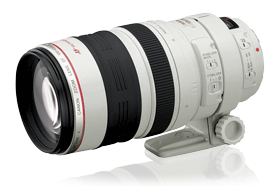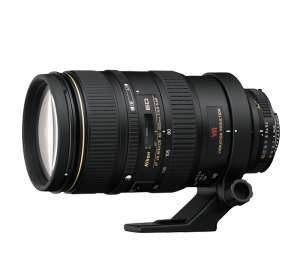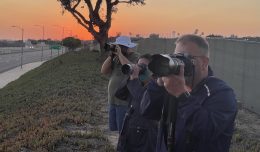(This week for Throwback Thursday, we take a look at aviation photographer extraordinaire Manny Gonzalez’s thoughts on how to pick the best lenses for your plane spotting kit. Originally published in 2011, most of these philosophies still hold true, even if some of the gear has since been updated.)
Aviation has many aspects that its enthusiasts enjoy. One of the strongest is aviation photography. Many more members of the hobby are taking up photography due to the explosion of easier-to-use digital cameras allowing almost anyone to produce excellent pictures of aircraft in motion or static display. Of all the components that make up a complete photography system, the camera and lens are arguably the most important.
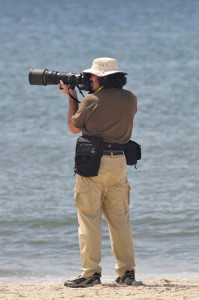
The Internet is replete with in-depth reviews, consumer opinion and an ocean of examples, so I will not dive into details better explained by those resources unless absolutely necessary. Instead I want to concentrate on basic principles and sound advice from experience gained in general photography as well as aviation photography both military and commercial.
For the record, the basis for my opinion below is from the point of view of achieving the highest quality images one can achieve. It is my goal to always produce the best photograph I can possibly obtain each time I press the shutter. This is achieved by a strong balance of quality optics, digital sensor or film and technical application by the photographer.
Focal Length
Of the various specifications that play a role in the decision, focal length should be considered first. Optical design, formula and quality, mechanical construction and reputation are all very important indeed and will be discussed as well. However, selecting the right focal length in my opinion is more important than the other aspects.
The focal length you want may not be what you need. Many believe they need a 500mm or even an 800mm lens when they really should be moving closer to the subject. There is a misconception between reach and magnification. A photographic (projection) lens really magnifies a subject in focus and projects an upside-down version of the scene on a sensor or film plane behind it. But that seems like a complicated explanation. To simplify as relative to our hobby, the distance between your spotting location and the aircraft being photographed is more important than the lens you select.
As a general rule, you want to have the minimal practical distance between your spotting position and the subject aircraft. Select your desired focal length so as to magnify the subject to fill as much of the frame as possible.
Here is more practical example. Say your spotting location is 1500 feet from the position of the aircraft. You will need a lens of 200mm focal length to adequately fill the frame of a crop sensor and 300mm to do the same on a full frame sensor for a subject such as a Boeing 777 or 747 or an Airbus A340 or similar large aircraft.
At the same distance, a longer focal length will be needed to magnify a smaller subject such as a Business Jet or Regional Jet; anything from 400mm to 600mm for crop or full-frame sensors respectively.
Note the distance has not changed. This is what I believe to be important in selecting the right focal length. I consider being a mile away from your subject the maximum practical distance where acceptable quality can be achieved. Using an 800mm lens from a distance of 8000 feet to achieve more reach will most likely result in a poor or unusable image. The longer the distance, the more atmospheric distortions being magnified. Depending on the altitude above ground of both the subject and the photographer, the amount of heat and other atmospheric distortions increases or decreases but never totally goes away. Even in the winter, there are vast amounts of heat distortion emanating from the ground. So keep your distance to a minimum and the magnification to a minimum.
Prime or Zoom
I will admit to being obsessed with quality. After years of experience with hundreds of lenses, a multitude of cameras and formats and lots of trial and error, I am quality obsessed.
With that in mind, a single focal length prime lens is the ultimate in quality. Without getting into too many technical details, variable focal length (zoom) lenses are typically of lesser optical quality than prime lenses. Prime lenses will afford you the highest levels of sharpness, contrast and color fidelity among other traits.
However I fully understand the need for both flexibility and portability. Zoom lenses offer a lot more flexibility in a single package than multiple prime lenses. This is a choice that can only be made by the photographer. Fortunately, the quality of select modern high end zoom lenses is on a par with similar prime focal length lenses.
In selecting a zoom lens, keeping in mind some basic rules will help in selecting a higher quality lens.
- Select a short zoom range over a long range. The longer the range, the more mechanical and optical compromises the manufacturer has to make.
- Constant aperture vs. variable aperture over the zoom range. This can be a costly proposition but the results will show. Constant aperture zoom lenses are typically higher quality models from most manufacturers. The variable aperture allows the manufacturer to manage the resulting physical characteristics of the lens.
- OEM vs. Third party lenses. This is a religious subject for some but I will risk it by saying that in my opinion, lenses from the top camera manufacturers today (Canon and Nikon) are more likely than not to be of higher optical and mechanical quality as those of third party manufacturers with very few exceptions. Doing proper research will reveal such exceptions where noted. If you rather not do the research, a matched OEM lens will typically perform as good as or better than lower priced alternatives.
The current crop of mid-range super-telephoto zoom lenses from Canon to Nikon to Sigma offer tremendous quality for the flexibility of a large number of focal lengths. There are also two standout higher end zooms of the quality you expect from a prime lens. The Nikon 200-400mm f/4 and the newly released Canon 200-400mm f/4 with built in 1.4x Teleconverter. These are expensive and excellent pieces of glass and reward the photographer with few optical or mechanical compromises; size and weight notwithstanding.
Of Pins and Cushions and Barrels and Aberrations
Once the decision is made on the focal length and prime or zoom, we concentrate on narrowing the field of lens quality based on published specifications and observed practical and controlled testing. As mentioned before, there are numerous internet websites for research, and it is also just as important to look at real user’s opinions and to look at example photographs, preferably untouched originals to formulate a decision.
These can be determined from the published specifications and tests from the manufacturer but I would put more emphasis on subjective tests done by reputable third parties and user opinion. Bascially, middle of the road lenses will enjoy wide ranging opinion while higher/lower quality lenses exhibit universal opinion pro or con.
Dollars and Sense
None of the above fits into a convenient-resulting cost. You will be faced with either spending money or investing money. I say think of a lens purchase as an investment. A lens should last you much longer than a camera body. Some good quality lenses manufactured in the 1970s still have no modern competition. That is the hallmark of a quality lens. Don’t think of the cost as a shock and don’t avoid the right lens because of cost. I challenge you to consider the results and satisfaction a quality lens will offer you and the enjoyment of the hobby.
I always told myself that if I did not buy the lens I really wanted up front I would end up paying more for it if I bought a cheaper alternative. In the end, you will find yourself purchasing the better optic. If you decide to spend money on a lesser optic, you may find yourself spending even more money to upgrade it in the near future.
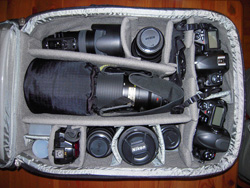
Some consider the intended use of the photos as a means to decide on purchasing low cost optics. Indeed if only publishing to the web in very small sizes, almost any lens/camera combination will yield good enough results. But if you ever intend on having a high quality collection of photographs, you will find comfort in using only the finest quality components. As with any tool, the better made ones cost more. A skilled technician will get good results from mediocre tools but better results from better ones.
I am very guilty of taking the path of being dollar wise and pound foolish and ended up spending a lot more in the end when I realized I was not satisfied with the results I was getting.
Toolkits
Here are some suggested well rounded kits. (Based on Nikon products. Similar options available from Canon, Sony, Sigma and others)
Full Frame
- 50mm prime. Excellent and typically low cost tool for your kit. It comes in handy when the light drops.
- 24-70mm zoom. Valuable when working distance is between 10 to 100 feet. An alternative and good quality yet lower cost option is a 24-120mm lens.
- 70-200mm zoom. A staple of any well rounded kit. It covers the most used focal lengths for subject distances from 100 to 1500 feet. Useful for situations that call for changes in subject dimensions and minimal subject distance changes.
- 300mm f/4 prime. Sharpness, contrast and color fidelity. Pairs very well with a teleconverter. Works best when subject distance changes little and/or subject size is somewhat fixed. Less flexible but higher quality.
- 1.4x teleconverter. It will expand the usability of your 70-200mm and 300mm lenses.
Crop Sensor
Similar to the above list with the following changes:
- 35mm prime. Replaces the 50mm above
- 17-55mm zoom. Replaces the 24-70m above
Compact package
- 35mm prime
- 70-300mm or 80-400mm zoom
Final Words
In selecting a lens for the further enjoyment of the hobby, it is my opinion that selecting the right focal length for the subject is most important with quality second and cost third. Consider moving cost to the middle if you are cost constrained but my advice is to sacrifice and save a little more to get the lens you really want and know to be better than a lesser cost one just for the sake of saving money.
Specifications, controlled and real world tests and user opinion and sample pictures should play an important role in your decision.
While I emphasize ultimate image quality as a primary goal, I fully understand and support the fact that some members lack the resources to purchase higher quality optics but the same principles above can be applied if cost conscious. Enjoyment of the hobby through photography can be achieved with lower quality lenses and that may be most important to you.



